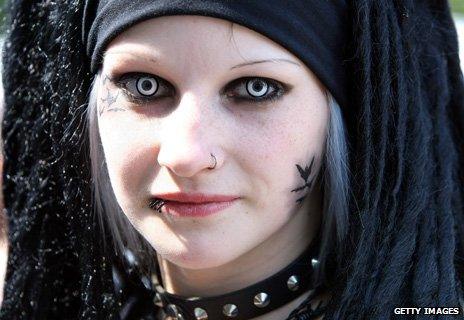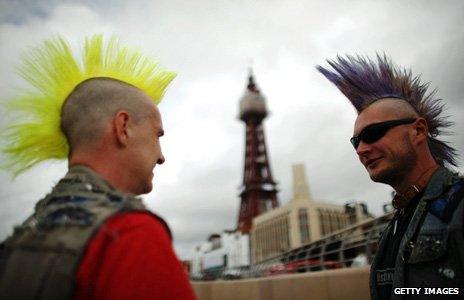How are goths and emos defined?
- Published

Police in Manchester have begun recording attacks on members of sub-cultures, such as goths, emos and punks, as hate crimes. But how do you define and protect these groups?
The problem of hate crimes against sub-cultures has been of mounting concern since the murder of Sophie Lancaster in 2007.
The student and her boyfriend were set upon by a gang of teenagers in a park. The victims were targeted because they were goths.
Previously, assaults have only been recorded as hate crimes when involving race, religion, disability, sexual orientation or transgender identity.
These groups can usually be demarcated relatively clearly, but is it more difficult to identify what makes someone a goth, emo or punk?
The Oxford English Dictionary defines a goth as "a performer or fan of [goth] music, or anyone who adopts a similar appearance, typically through the use of dark eye make-up and pale skin colouring, dark clothes, and bulky metallic jewellery".
Goth.net, one of the most active forums on goth culture, acknowledges the role of dark clothing but rejects the notion that goths have the same musical and fashion tastes. Central to their definition is "free-thinking and rejection of dogma".
The OED's definition of emo is purely musical: "derived from hardcore punk music and characterised by emotional, usually introspective lyrics".
While people might have certain assumptions about the way emos dress, precise delineations are not clear. They often dress similarly to goths, but the emo fashion for spiky, coloured hair and studded clothing seems to show punk influences.
One thing that is clear from the way emos and goths choose to define themselves is that a single definition does not exist.
Emo and goth identity is discussed in detail among both communities online. Many goths and emos feel sidelined by mainstream society and see their goth or emo identity as a way to express this.
Debates rage among the online communities about what music and fashion is or is not goth or emo, but all see it as an effective way of expressing themselves. It creates a sense of community and feeling that they belong.
"They are not easy groups to define," says Paul Hodkinson, a goth himself and a sociologist at the University of Surrey, who specialises in youth subcultures.

Gerard Way of My Chemical Romance encapsulates one type of emo style
"Goths and emos are in some ways quite similar - they both centre upon dark themes and wear dark colours and often eyeliner. The goth style draws on horror imagery, and both sexes often favour a 'feminine' style."
Emos are sometimes seen as a younger offshoot of the Goth scene, Hodkinson suggests, though emo also has connections to hardcore punk.
Greater Manchester Police named goths, punks, emos and metallers as people of an "alternative sub-culture identity" in their definition of hate crimes.
The problem of violence and discrimination has existed for some time, says Alex Milas, editor of Metal Hammer, a metal music magazine.
"Many stereotypes have been broken down over recent years. This is an acknowledgment that we do exist as a group of people, there is a problem, and we are victims of harassment and violence."
"Identification causes problems, however. I have long hair and like metal music, but have no facial piercings. Am I 'metal' enough to be protected?"
Like other hate crimes, what has taken place is largely defined by the victim. If the victim says they are an emo, and believes they were victimised because of it, Manchester police would treat it as a hate crime.

Where police have not been able to establish a crime was committed, they can record a lesser "hate incident".
"Self-definition is the only viable option available," says Jon Garland, a criminologist at the University of Surrey, who specialises in hate crimes. "However, it still leaves the question of who counts as alternative and who doesn't. Skaters are a group that probably should be recognised. They are often victims of these kinds of attacks, but it is not clear if they are included."
The police need to know how to spot a goth or an emo if they are to be able to properly protect them from attacks, but they are aware that their definitions must remain adaptable.
Of course, there will be plenty of people who recognise themselves as being in some sort of sub-culture but believe that identifying individuals using a checklist is impossible.
Having a list of protected groups also risks excluding people for whom the difference in their appearance - like skaters - may be less obvious, but who still need some sort of protection.
Lucy Robinson, a historian at the University of Sussex specialising in identity politics, argues that young people have moved away from narrow concepts of identity and tend to have "a collection of varied cultural identities".
"A lot of the issues are about power, not identity. The clothing and style of goths and emos challenge traditional gender roles and perceptions of female beauty. The attacks on them involve issues such as misogyny, homophobia and class prejudices."
Ultimately, many goths and emos will feel that whatever the complications of identifying vulnerable groups, even acknowledging the problem is a step in the right direction.
You can follow the Magazine on Twitter, external and on Facebook, external